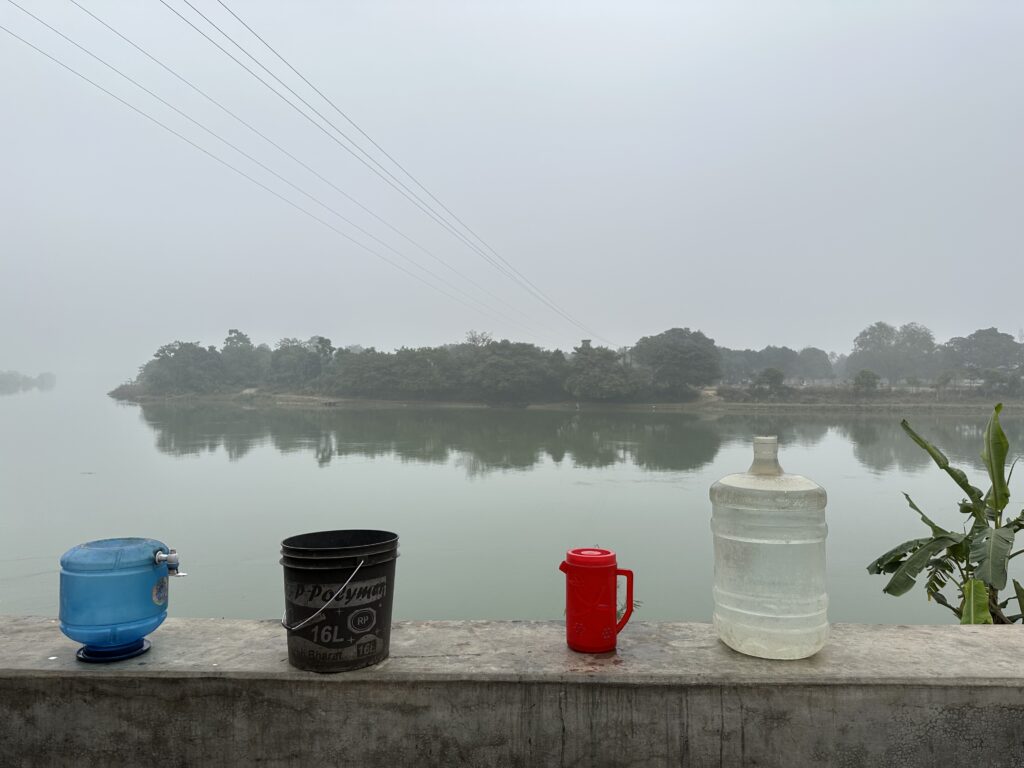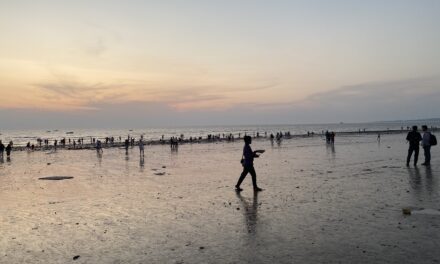Four hours and a bit through a city that spelt wealth and power just a couple of centuries ago. Murshidabad. So much happened here, the erstwhile capital of India’s richest province, possibly the world’s even… Bengal. Staying for a couple of days at a home, a kothi turned to heritage hotel of one of the several wealthy Oswal Jain families that settled here back in the 1700s. Not the Nawab, nor his family, not Jagat Seths (those wealthiest bankers of all), just one of the Oswal Jain business families that lived here in Baluchar on the banks of Bhagirathi, in the area called Azimganj. You should see their thunking humongous house with seven courtyards… how many thousand square feet is this one I had to ask. Once in Murshidabad, this was nothing unusual. It was the city of the rich and famous, this is where the last Nawab of Bengal lived, and managed to mismanage things so much that we tumbled into another history, another world. Alice in wonderland thoughts as I mull over this astonishing city.
A few images and the thoughts they bring.

A macabre tale about a princess, perhaps a way to get rid of her? Was she buried alive? I stare at the bright paddy fields through the arch in the ruin of a mosque she wanted to build, or did build, but which an earthquake took. Below in her grave lies the daughter of Murshid Quli Khan, Azimunnisa. The tales liven up a tourist guide’s spiel at the tomb of the unfortunate Begum.

The Nawabs had already become playthings in the hands of the new rulers from another continent when this palace was constructed. Hazarduari (with a thousand doors) Palace in Murshidabad, which actually has 1,000 doors, 100 of which are fake, to trick and catch outsiders or thieves. Built by Mir Jafar’s (the man who would always be known as traitor) descendant Nawab Nazim Humayun Jah of Bengal, Bihar, Orissa. Duncan Macleod was the architect. The foundation stone was laid on 9 august 1829, construction completed in 1837.

The endless Nizamat Imambara opposite the Hazarduari Palace. Opens only 10 days a year for Moharram. The original Imambara built by Shiraj ud Daulah was destroyed in a fire. This was built in 1847 by Nawab Mansur Ali Khan.

The yellow mosque in the palace complex, said to have been built by Shiraj ud Daulah in 1756/7, around the time he would lose a battle that would utterly change our world.

Once there were wood rose or kath golap gardens here. From that the name Kathgola Palace, the residence of the Sheherwali Jain Dugar family, that is now a museum. Oswal Jains like the Dugars, the Dudhorias, whose kothi was our hotel, the Jagat Seths, were also known as Sheherwali Jains, having moved to urban trading centres from rural or small town places in Rajasthan that lay almost 2,000 kilometres to the west. A rather lovely home this, with tall doors, 32 feet high ceilings, beautiful architecture and art. At the entrance, a room with cupboards full of wonderful books. Set amid 90 acres of land with gardens, temples, orchards, now even a zoo. The owner had the usual fight with brothers to get the place, what’s life without a little warring with family, some happy intrigue… in this case, seems the latter was provided by a well which was in reality a secret passage to the Jagat Seth’s home.

In the gardens of Kathgola Palace, the lovely tall stemmed Cosmos.

Nashipur Palace, the court of Raja Debi Singha, who collected taxes for the British. During the horrific Great Bengal Famine of 1770, he decided not to show mercy or relent, but tortured people to get money out of them. Between seven to ten million people lost their lives in the famine it is believed. I tried not to listen to the terrible account delivered in chaste Bengali English, and focussed on the ladies on the Tanga.


At the house of the great traitor. Though really who wasn’t one? Jagat Seths? Raja Naba Krishna Deb? Ghaseti Begum? The merchants who plotted? And anyway, it was all about money, not really about country and country love.

Dropping in on Mir Jafar.

Is this the Motijheel Mosque? Think Ghaseti Begum just walked into my trip. If it is that Masjid, her adopted son (Shiraj ud Daulah’s brother) and husband are buried here. Nawab Aliverdi Khan’s eldest daughter, Meharunnissa Begum, urf Ghaseti Begum, would often visit this mosque, she, another conspirator who’d bring about the famous defeat at Plassey.



Two minarets destroyed in an earthquake, which also shattered its domes leaving gaping empty spaces in the ceiling, the Katra Mosque of Murshid Quli Khan is still absolutely beautiful. Even haunting. In its complex, one of the largest caravan sarais once, a huge space for prayers, and below the staircase, the Nawab’s last resting place. The man who became the first Nawab of the wealthy Bengal Subah. The man who moved his capital from Dhaka to this city by the river Bhagirathi and named it after himself (or did Aurangzeb, pleased with the money he was making for the Mughal treasury, grant him this honour?). The man who was once the boy Surya Narayan Mishra who’d be sold, how his life would change. The expanse of brick and sky through the jagged edges of the broken domes call you to another time. The Bhagirathi flows all knowing and silent somewhere nearby.


Looking at Jiaganj across the river, from Azimganj. Once all of this was Baluchar in Murshidabad, and the river flowed along a different course. The Farakka Barrage, around 80 kilometres in the north, has changed the swell and sway of this waterway, a part of the Ganga, its name suffused in mythology. Did the ancestor of Rama of the Ikshvaku dynasty, King Bhagiratha of Ayodhya, really bring Ganga down to earth through prayers and penance to Shiva, to complete the funeral rites of his 60,000 ancestors?

The fake Jagat Seth House. The real house some say was swallowed by the river.

Bari Kothi, once the home of the Oswal Jain Dudhodias, the eldest brother’s home, now a heritage hotel where we stayed. An immense restoration project has got the sprawling, seven-chowked mega mansion pretty much returned to its old glory… some glitches remain, adding texture. I love the crazy colours all around, and all the details and chandeliers, and stories waiting to be heard.






